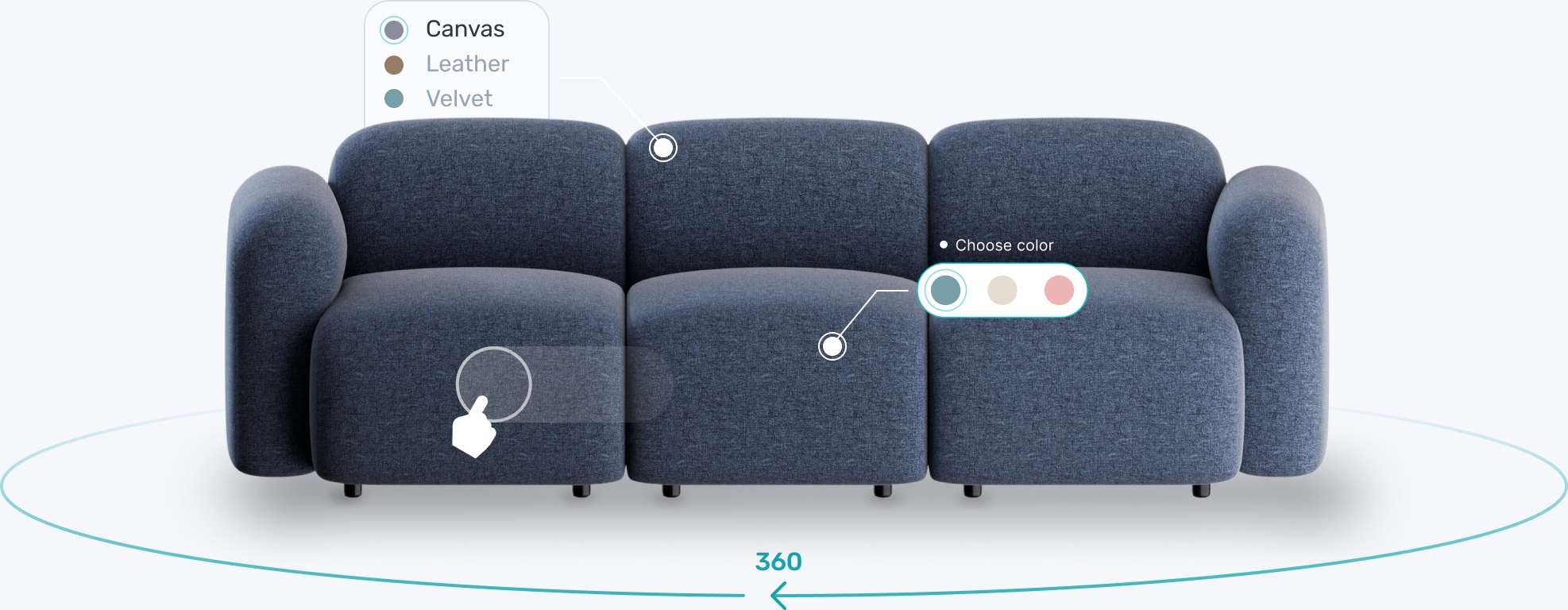Transform your eCommerce strategy with 3D & AR





For furniture brands still looking to put 3D and augmented reality (AR) technology to the test, the pandemic became a major catalyst for those yet to dip their toes into 3D waters. Out of the various product types that US consumers want to shop using AR, furniture comes out on top, with 60% of US online customers wanting to explore 3D furniture models before making a purchase.
Over the past two years, many more furniture companies have made the switch, discovering how much more flexible and cost-effective 3D visualizations are compared to traditional 2D photography. And also how, by adding a layer of digital interactivity, customers shop with more confidence and make better decisions that lead to fewer product returns.
3D and AR technology are fast becoming a staple in the furniture industry, especially in eCommerce. But even offline, they give brick and mortar stores the opportunity to showcase their full product range well beyond the physical capacity of their stores. And the applications go even further, with 3D and AR also used in prototyping, design, and manufacturing.
In fact, 2021 was the most active year to date for 3D and AR across the furniture industry, leading to an increase in interactive digital experiences that will see even wider adoption in the years to come. Looking at three different furniture retailers, this blog examines the reasons and outcomes of furniture brands that switched to 3D and AR.

Garten und Freizeit, a German eCommerce retailer specializing in high-quality outdoor furniture, turned to 3D for three key reasons:
After selecting a small local 3D partner, they immediately saw conversions increase up to 60%. However, the local provider could not match the speed and scale the company needed. So they reached out to Modelry to create and manage a scalable 3D content production pipeline. Collaborating with Modelry further enabled Garten und Freizeit to create visuals and process changes within a timescale and budget that wasn’t possible with traditional photography.
Overall, the solutions improved the customer experience and promoted greater on-page engagement. Website visitors can now also view products in full 360º and even see them within a virtual showroom. What they hadn’t anticipated was that their return rate also dropped, making it that much more profitable than expected.
Modelry is the ideal solution to overcome the barriers to adoption of AR and VR across our online platform. It combines the full scalability, ease of implementation, and efficient 3D model delivery that we require – all in one solution. Juergen Schuster, Founder and CEO, Garten und Freizeit
Even furniture customers that still value the physical shopping experience can benefit from 3D. Cadena88 is the leading hardware chain with the largest network of brick and mortar stores in Spain, with more than 1400 points of sale. For Cadena88, the primary challenge was how to increase stock or venture into new product areas without investing in more stores.
Before implementing 3D, Cadena88’s standard product lines included pots and pans, pipes, and DIY tools, already maxing out their existing capacity. But as the pandemic hit, the large firm saw an opportunity to capitalize on the demand for garden tables, chairs, and other styles that would complement their existing customer base.
Recognizing that Spanish shoppers still prefer community-based stores to online shops, Cadena88 opted to blend the use of 3D and AR eCommerce into their physical stores using tablets. This creative structure allowed customers to see 3D furniture in AR both at home and in-store alongside their stellar customer service team. And after a storewide rollout of tablets, the company saw sales of their new collections double without any additional real estate spend.
We started with only 10 models, and it was a huge success. Suddenly, these small shops were able to show a lot of very big products. Even in tiny stores, you can show one product and another one and all the details of them. Now, all of our stores have tablets that can show everything to the customer. Jordi Fernandez, CIO of Ehlis S.A., Central purchasing body of Cadena88.
[#gal1]
Top-spec commercial light suppliers Crystorama provide chandeliers to some of the world’s most prestigious institutions, such as the US Supreme Court and the Palace Theatre. After seeing the success enjoyed by their competitors, Crystorama turned to 3D to showcase their stunning light designs.
For Crystorama, the flexibility and simplicity offered by 3D virtual photography meant that they could adapt furniture marketing materials to new interior design trends much faster than traditional photography. With a single 3D model, Crystorama can style each item in photorealistic 3D lifestyle scene renderings however they choose.
Rather than having to commission expensive on-site photoshoots for every design change, a single 3D artist can blend the work of an entire team of photographers and stylists. Elements such as a coffee table or chair can be manipulated virtually to order by one person. This refined process helped them save on costs while expediting orders for any new products or seasons.
Using 3D lifestyle scenes, furniture brands can:

Ecommerce has faced many challenges over the past few years, motivating more brands to consider digital solutions like 3D and AR. Overall, these technologies help any furniture business to lower costs, increase workflow efficiencies, increase conversions, and lower return rates.
For consumers, by simply interacting with AR experiences and 3D models online they get the chance to make better-informed furniture shopping decisions. So that when purchases do arrive, they are just as expected.
Modelry has already helped many furniture companies make the transition to 3D, converting tens of thousands of models into AR-ready assets. Contact us to discuss your furniture marketing strategy or sign up for free to get started today.




